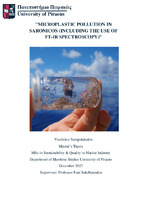| dc.description.abstractEN | This study delves into the ubiquitous presence of plastic, now designated as key
indicators of the distinct historical era called "The Plasticene." The durability of plastics
and their fragmentation into microplastics have raised concerns about global
environmental issues. Microplastics, which result from the decomposition of larger
plastic debris, signify the Anthropocene with widespread global distribution and
diverse origins, including everyday items. They pose challenges in understanding their
behavior in marine and coastal environments, because they accumulate in various
reservoirs. Impacts are shifting to the ingestion of microplastics, which act as vectors
for contaminants. Plastic pollution extends to humans through trophic transfer,
potentially causing adverse health effects. Concerns include indirect economic impacts,
safety issues, and damage to human activities. Various polymer types contribute to
plastic pollution, so precise methods are needed to accurate investigate microplastic
pollution. The exponential growth of global plastics production requires urgent research
to quantify contamination and assess its impact, emphasizing the importance of
informed management solutions for marine ecosystems and human health.
This study highlights the pervasive issue of microplastics in marine environments by
presenting their characteristics, distribution, and impacts. Below, the origin and types
of plastic are clarified, the term plastic is defined and the transition from plastics to
microplastics is explained. The focus then shifts to the identification of polymer types,
the characterization of microplastics in terms of particle size, shape, and color, and the
understanding of the relationship between these characteristics and abundance.
The transport of microplastics is explored in depth, covering factors affecting
abundance and distribution, distribution in ocean surfaces, and their presence in
terrestrial ecosystems. Additionally, the study investigates the weathering degradation
of microplastics in the ocean, shedding light on the persistence of these pollutants.
The impacts of microplastics on marine ecosystems has been investigated, with a focus
on the exposure through gills, ingestion, and the transferability of these particles up to
the food chain. The study also assesses the broader impacts on the environment and
human health, highlighting the interconnectedness of marine and human ecosystems.
In addressing the management of microplastics, the study explores mitigation
strategies, biodegradation, and mineralization methods. The development of sampling
protocols for microplastics at the sea surface is detailed, covering the environmental
setting of sampling areas, methods and techniques in aquatic environments, and various
microplastic analysis methods. The importance of quality control, contamination
minimization, and data interpretation and analysis are underscored, with validation of
microplastic quality control and analysis methods.
The study concludes by emphasizing the significance of investigating microplastics to
understand their distribution, abundance, and environmental effects. Identified
knowledge gaps in the field pave the way for future research, while best practices for
reducing microplastic pollution and strategies for education and public engagement are
proposed. The comprehensive exploration culminates in a call for urgent action and
informed management solutions to safeguard marine ecosystems and human health
from the escalating threat of microplastic pollution. | el |



